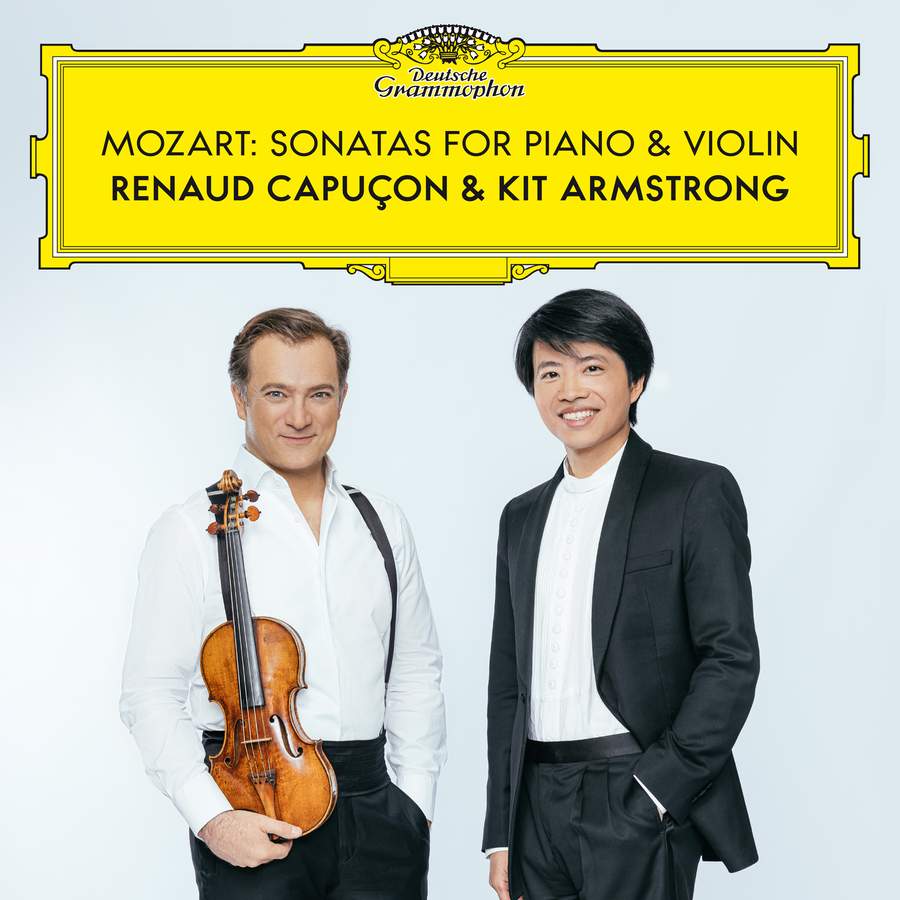MOZART Violin Sonatas (Renaud Capuçon)
View record and artist detailsRecord and Artist Details
Composer or Director: Kit Armstrong
Genre:
Chamber
Label: Deutsche Grammophon
Magazine Review Date: 09/2023
Media Format: CD or Download
Media Runtime: 298
Mastering:
DDD
Catalogue Number: 486 4463

Tracks:
| Composition | Artist Credit |
|---|---|
| Violin Sonatas Nos 17 - 28 |
Wolfgang Amadeus Mozart, Composer
Kit Armstrong, Composer Renaud Capuçon, Violin |
| Variations, '(La) bergère Célimène' |
Wolfgang Amadeus Mozart, Composer
Kit Armstrong, Composer Renaud Capuçon, Violin |
| (6) Variations, 'Hélas, j'ai perdu mon amant' |
Wolfgang Amadeus Mozart, Composer
Kit Armstrong, Composer Renaud Capuçon, Violin |
| Sonata for Keyboard and Violin No. 32 |
Wolfgang Amadeus Mozart, Composer
Kit Armstrong, Composer Renaud Capuçon, Violin |
| Sonata for Keyboard and Violin No. 33 |
Wolfgang Amadeus Mozart, Composer
Kit Armstrong, Composer Renaud Capuçon, Violin |
| Sonata for Keyboard and Violin No. 35 |
Wolfgang Amadeus Mozart, Composer
Kit Armstrong, Composer Renaud Capuçon, Violin |
| Sonata for Keyboard and Violin No. 36 |
Wolfgang Amadeus Mozart, Composer
Kit Armstrong, Composer Renaud Capuçon, Violin |
Author: Rob Cowan
When is a violin sonata not a violin sonata? When it’s by Mozart, we’re told, the idea with him, metaphorically speaking, that the violinist is a sidecar passenger while the pianist presses on the gas – as indeed Mozart himself probably would have done in recital. That more or less is how things were in those days, though in the case of the famous Italian violinist Regina Strinasacchi (the dedicatee of K454) I’d imagine a touch of role-reversal would have been brought into play. Most recorded editions of the mature sonatas call the works, simply and unequivocally, ‘Mozart Violin Sonatas’, whereas this stimulating set featuring two of the present generation’s most gifted instrumentalists opts for ‘Sonatas for Piano & Violin’. Nothing novel there. Back in the mid-1950s for pianist Carl Seemann and violinist Wolfgang Schneiderhan (newly reissued in ‘Wolfgang Schneiderhan: Complete Recordings on DG’ – see page 94) DG prioritised the piano in exactly the same way.
So let’s select a test case, one of my favourite sonatas, No 27 in G major, K379, composed in 1781. Kit Armstrong opens the work’s gorgeous Adagio with warmly brushed arpeggios, answered with voluptuous address by Renaud Capuçon. He’s by no means in tow, that’s for sure. A little later on Capuçon wafts in on the softest tonal thread (2'30") before, at 3'39", Armstrong launches a spirited Allegro. Seemann’s opening measures are more austerely classical than Armstrong’s, and Schneiderhan’s forceful entry at 0'38" makes it perfectly clear that, no matter what the stated designation, this is coming across as a violin sonata pure and simple, the Allegro once launched following suit, Schneiderhan close by, Seemann supportive, yes, but by no means the dominant partner.
Ingrid Haebler and Henryk Szeryng play Mozart ‘violin sonatas’ (according to the ‘Duo’ CD sleeve), Haebler opting for warmth and clarity, Szeryng congenial but relatively earnest, though once into the Allegro Haebler calls the shots. The version with Arthur Grumiaux and Walter Klien (again billed as ‘violin sonatas’) finds Klien approaching the Adagio in a style midway between Armstrong and Haebler, though once into his stride he pushes the tempo forwards. Grumiaux, while typically expressive, is relatively restrained so here again there is a contradiction between the designation and the performance. This is more a ‘sonata for piano and violin’.
All these recordings come packaged among the ‘great’ sonatas (K296-547, with a couple of sets of variations), which is what Armstrong and Capuçon also offer us. Another piece that always flies straight to the heart is the two-movement Sonata in E minor, K304 (one of the group K301-306 from 1778), with its conversational opening, the piano and violin playing in unison. Here sweet-toned Itzhak Perlman and Daniel Barenboim (always a big player) deliver the goods as required but Armstrong and Capuçon are rather more individual, Armstrong’s piano-playing almost stand-alone in its forthrightness, Capuçon varying his tone and phrasing to magical effect. As played, the second movement’s bittersweet middle section is quite gorgeous (especially from Capuçon), and I love the way Armstrong glides back into the outer section. Arthur Grumiaux and Clara Haskil are also memorable in this music (though Grumiaux is too forwardly balanced) and so are Hilary Hahn and Natalie Zhu (‘violin sonatas’ again, and like Grumiaux more overtly emotional than Armstrong and Capuçon).
Other memorable performances include the E flat Sonata, K481, one of the cycle’s masterpieces, though in the Adagio some of Armstrong’s emphases are a little over-stressed (maybe a sign that he loves the piece so much, as Raoul Mörchen states in his excellent booklet note). But, again, you sense a genuine rapport between these two excellent players. Happily, when I was commissioned to prepare this review, I already had a copy of the set in my possession, which I hadn’t yet opened. Once listening, I kept going from the beginning to the end, taking a break only for supper – I enjoyed the set that much. Here we have superior musicians on a roll in some great music, and the fact that we’re privileged to share in their joy is cause for celebration. Excellent, well-balanced sound adds to the deal. Very strongly recommended.
Discover the world's largest classical music catalogue with Presto Music.

Gramophone Digital Club
- Digital Edition
- Digital Archive
- Reviews Database
- Full website access
From £8.75 / month
Subscribe
Gramophone Full Club
- Print Edition
- Digital Edition
- Digital Archive
- Reviews Database
- Full website access
From £11.00 / month
Subscribe
If you are a library, university or other organisation that would be interested in an institutional subscription to Gramophone please click here for further information.




